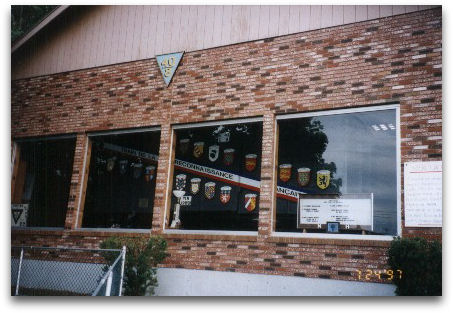PLEASE NOTE: Do not search for this cache late at night and at all times be mindful of the homes surrounding you. You will NOT need to walk on any grass to find this cache! The cache is NOT in the black lamp posts, that is private property.

The cache is located at the Merci Box Car, a gift from France after World War II. The cars were built between the years of 1872 and 1885, which means any that are still standing today are more than 135 years old. The car is illuminated for viewing during the evening, but not all night. This is one of my favorite types of hides, and if you haven't seen one like it before it might be a little tricky
The slightly odd location of this historical train car probably keeps many of Manchester's own residents from knowing anything about it. I did some searching and dug up the back story from a couple of different sources. Here is a summary:
The Hommes 40-Chevaux 8 and the Merci Train
After the end of World War II, much of Europe remained in ruins and in 1947, American newspaper columnist Drew Pearson inspired a campaign that collected food and clothing for the people of France and Italy. $40 million in food and supplies were collected and shipped to Europe aboard the 700-car American "Friendship Train." In appreciation for the generosity of the Americans, the citizens of France responded by sending 49 boxcars—one for each state at the time — full of gifts to America. All of the items were loaded in "40 & 8" boxcars, and each car was decorated with the coats of arms of all of the provinces of France. (1)
Although many in that war-ravaged country had little but sentiment to offer, more than six million families helped to fill the cars. Most of the 52,000 carefully packaged and crated gifts were worth little in money, yet some were priceless. They included childish drawings on rough, yellowed paper; puzzles mounted on cardboard frames; ashtrays made of broken mirrors; worn-down wooden shoes; hand-crocheted doilies; battered toys; the original bust of Benjamin Franklin by the great French Sculptor, Jean Antoine Houdon; a jeweled Legion d'Honneur once presented to Napoleon; the bugle which signaled the Armistice signing at Compiegne in 1918; 50 rare paintings; a Louis XV carriage; and the first motorcycle ever built.(2)
Each state established committees to catalog and distribute its share of the cargo. In most cases the gifts were initially exhibited in capitals or major cities and then sent on state-wide tours. Afterwards, the were distributed in a variety of ways. A few, addressed to specific individuals or institutions, were delivered in accordance with the sender's wishes. In some states, the contents were sold at auction and the proceeds given to charities; elsewhere, selected items were turned over to veterans hospitals, orphan homes, schools and churches. Articles suitable for permanent display were generally placed in state and private museums, libraries and other public institutions.(2)
More information on the Merci Train: NH.gov - WWII Federation - MerciTrain.org
Today, the train car sits in a building that was graciously constructed by Fred Teague, Sr. (US Navy, ret.) and the American Legion fraternity La Société des Quarante Hommes et Huit Chevaux (The Society of Forty Men and Eight Horses). This fraternity is of course named after the "40 & 8" boxcars as they were designed to carry 40 men or 8 horses. I always thought this was a neat little peice of history that many people don't even notice. If you enjoyed this cache please consider giving it a favorite point :-) Thanks, and have fun!
Congrats to wemedge for FTF!